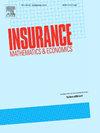Optimal investment strategy for DC pension with mean-weighted variance-CVaR criterion under partial information
IF 2.2
2区 经济学
Q2 ECONOMICS
引用次数: 0
Abstract
This paper studies an asset allocation problem of defined contribution (DC) pension with partial observation and minimum guarantee constraint. In the general framework of the financial market, the investment optimization problem under partial information is transformed into the problem under complete information by using the measure transformation approach. Then two auxiliary processes are introduced to tackle the non-self-financing property of the wealth process. With the mean-weighted variance-CVaR criterion, the optimal terminal surplus and the optimal investment strategy are derived by the martingale method. In order to obtain the concrete expression of the optimal investment strategy, we focus on a particular financial market where three kinds of assets are available, including the risk-free asset, the zero coupon bond and the stock. We assume that the return rate is modulated by a hidden Markov chain and the interest rate is described by the Vasicek model. The analytical expression of the optimal investment strategy is derived by adopting the Wonham filter theory and the Malliavin calculus. Finally, the numerical analysis related to the optimal terminal wealth, the optimal investment strategy and the values of risk measures is carried out to illustrate the theoretical results.
部分信息下基于均值加权方差- cvar准则的养老金最优投资策略
本文研究了具有部分观察和最低保障约束的养老金资产配置问题。在金融市场的一般框架下,利用测度变换方法将部分信息下的投资优化问题转化为完全信息下的投资优化问题。然后介绍了两个辅助过程来解决财富过程的非自筹资金属性。利用均值加权方差- cvar准则,用鞅方法推导出最优终端盈余和最优投资策略。为了得到最优投资策略的具体表达式,我们关注一个特定的金融市场,其中有三种资产可用,包括无风险资产、零息债券和股票。假设收益率由隐马尔可夫链调制,利率由Vasicek模型描述。采用Wonham滤波理论和Malliavin微积分导出了最优投资策略的解析表达式。最后,对最优终端财富、最优投资策略和风险度量值进行了数值分析,以说明理论结果。
本文章由计算机程序翻译,如有差异,请以英文原文为准。
求助全文
约1分钟内获得全文
求助全文
来源期刊

Insurance Mathematics & Economics
管理科学-数学跨学科应用
CiteScore
3.40
自引率
15.80%
发文量
90
审稿时长
17.3 weeks
期刊介绍:
Insurance: Mathematics and Economics publishes leading research spanning all fields of actuarial science research. It appears six times per year and is the largest journal in actuarial science research around the world.
Insurance: Mathematics and Economics is an international academic journal that aims to strengthen the communication between individuals and groups who develop and apply research results in actuarial science. The journal feels a particular obligation to facilitate closer cooperation between those who conduct research in insurance mathematics and quantitative insurance economics, and practicing actuaries who are interested in the implementation of the results. To this purpose, Insurance: Mathematics and Economics publishes high-quality articles of broad international interest, concerned with either the theory of insurance mathematics and quantitative insurance economics or the inventive application of it, including empirical or experimental results. Articles that combine several of these aspects are particularly considered.
 求助内容:
求助内容: 应助结果提醒方式:
应助结果提醒方式:


